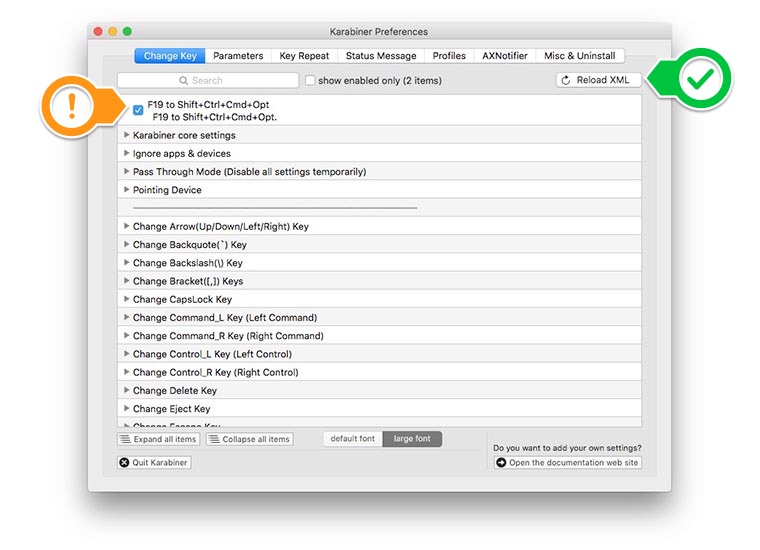
- #Karabiner elements f19 for escape and control how to
- #Karabiner elements f19 for escape and control install
- #Karabiner elements f19 for escape and control software
- #Karabiner elements f19 for escape and control code
- #Karabiner elements f19 for escape and control mac
Instead of asking about X, you ask about Y. You want to do X, and you think Y is the best way of doing so. My original question suffers as an XY Problem. The Alt key is not really a working solution because of how many terminal emulators deal with it and the Cmd key is Mac-only and only works in MacVim anyway.Īt that point, if you are ready to mash four keys together to emulate the function of only one key (which in itself is rather silly), you might as well simply use which, AFAIK, works everywhere. That means that, if the terminal doesn't eat them up (which it does), you can only do or. It won't register more than one modifier with a normal key. The Shift, Alt, Cmd and Ctrl keys don't do anything on their own and Vim rightfully does nothing but wait for further keypresses when you hit them.Īdditionnaly, Vim's input mechanism is a bit "old school", most probably to keep it consistent over the multiple platforms it may run on. "Modifiers" are called "modifiers" for a reason: they are used with normal keys to "modify" their meaning. With the System Preferences it's trivial to map Caps Lock to one of those keys.No, you can't map four modifiers. Your pick )Įdit: Just noticed solution 3, if you're using MacVim you can use Ctrl, Option and Command as Esc. So, it's rather a complicated, half-baked solution or installing a third-party piece of hackery. I didn't get it to work with vim in the Terminal and I haven't tested it with MacVim. You can then map the Help and the Insert key to Esc in vim. But if it is, it will be treated as the insert key, which you probably don't use anyway, since you ask about remapping your Caps Lock to prevent stretching your hands ) The trick is to map the Caps Lock key to the Help key (code 6), which isn't on most keyboards. Also, you can of course use the Property List Editor instead of going through the XML conversion steps. As addendum to that hint I suggest you first set Caps-Lock to None in the System Preferences, then you only need to change one value in the. The process is described in this article. OS X supports mapping the Caps Lock key to a whole bunch of keys, but you have to do it 'by hand', editting. This solution doesn't involve patching the keyboard driver, but gives you a Vim specific solution. Enable ‘Change Caps Lock’ and set the keycode to 53.Go to PCKeyboardHack in System Preferences.
#Karabiner elements f19 for escape and control install
#Karabiner elements f19 for escape and control code
If that sounds good to you, take a look at hidutil.įor example, to remap caps-lock to escape, refer to the key table and find that caps-lock has usage code 0x39 and escape has usage code 0x29.

No need to install any 3rd-party crap like PCKeyboardHack / Seil / Karabiner / KeyRemap4MacBook / DoubleCommand / NoEjectDelay.No need to fiddle around with system GUIs.

In macOS Sierra 10.12, Apple introduced a new way for users to remap keys. I wasn't happy with any of the answers here, and went looking for a command-line solution.
#Karabiner elements f19 for escape and control mac
These utilities offer unlimited flexibility when remapping the Mac keyboard. After a little tweaking I have mine set to toggle the AirPort Wifi. PQRS also has a great utility called NoEjectDelay that you can use in combination with KeyRemap4MacBook for reprogramming the Eject key. Here's a screenshot to show a few of the (hundreds of) pre-selectable options: I have no affiliation with them but I've been using these tools for a long time and have to say the guys over there have been doing an excellent job maintaining these, adding features and fixing bugs. If you like these tools you can make a donation. You may also want to check out KeyRemap4MacBook which is actually the flagship keyboard remapping tool from - it's also free. In the popup dialog set Caps Lock Key to No Action:Ģ) Now, click here to download Seil and install it:ģ) After the installation you will have a new Application installed ( Mountain Lion and newer ) and if you are on an older OS you may have to check for a new System Preferences pane:Ĥ) Check the box that says "Change Caps Lock" and enter "53" as the code for the escape key:Īnd you're done! If it doesn't work immediately, you may need to restart your machine.
#Karabiner elements f19 for escape and control how to
Here's my attempt at a comprehensive, visual walk-through answer (with links) of how to achieve this using Seil (formerly known as PCKeyboardHack).
#Karabiner elements f19 for escape and control software
Thus it is no longer necessary to install third-party software to achieve this. Edit: As described in this answer, newer versions of MacOS now have native support for rebinding Caps Lock to Escape.


 0 kommentar(er)
0 kommentar(er)
